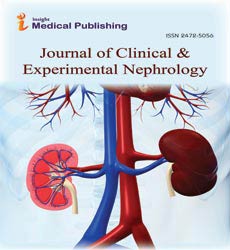Peritoneal Dialysis: A Patient-Centered Approach to Managing Chronic Kidney Disease
Pedro Michel*
Department of Nephrology, Pennsylvania State University, Pennsylvania, USA
Published Date: 2024-08-16DOI10.36648/2472-5056.9.4.265
Pedro Michel*
Department of Nephrology, Pennsylvania State University, Pennsylvania, USA
- *Corresponding Author:
- Pedro Michel
Department of Nephrology, Pennsylvania State University, Pennsylvania,
USA,
E-mail: michel_p@gmail.com
Received date: July 16, 2024, Manuscript No. IPJCEN-24-19687; Editor assigned date: July 19, 2024, PreQC No. IPJCEN-24-19687 (PQ); Reviewed date: August 02, 2024, QC No. IPJCEN-24-19687; Revised date: August 09, 2024, Manuscript No. IPJCEN-24-19687 (R); Published date: August 16, 2024, DOI: 10.36648/2472-5056.9.4.265
Citation: Michel P (2024) Peritoneal Dialysis: A Patient-Centered Approach to Managing Chronic Kidney Disease. J Clin Exp Nephrol Vol.9 No.4: 265.
Description
Peritoneal Dialysis (PD) is an increasingly recognized and valuable treatment option for individuals with Chronic Kidney Disease (CKD), especially those who reach End-Stage Renal Disease (ESRD). While hemodialysis remains the more common form of renal replacement therapy, peritoneal dialysis offers distinct advantages that align well with a patient centered approach to healthcare. By providing more flexibility, independence and a quality of life that can be closer to normal, PD stands out as a vital option for many patients. Peritoneal dialysis leverages the body's peritoneal membrane a layer of tissue lining the abdominal cavity as a natural filter. During the procedure, a dialysis solution, called dialysate, is infused into the peritoneal cavity through a catheter. The solution absorbs waste products and excess fluids from the blood, which are then drained out of the body. This process can be done multiple times a day Continuous Ambulatory Peritoneal Dialysis (CAPD) or overnight with the aid of a machine Automated Peritoneal Dialysis (APD).
Advantages of peritoneal dialysis
One of the most significant advantages of peritoneal dialysis is the freedom it offers patients. Unlike hemodialysis, which typically requires visits to a dialysis center three times a week, peritoneal dialysis can be done at home, at work, or even while traveling. This flexibility allows patients to maintain a more normal lifestyle and manage their treatment around their schedules rather than the other way around. This preservation because residual kidney function contributes to better overall health outcomes, including lower mortality rates and fewer complications. Patients on peritoneal dialysis often enjoy fewer dietary restrictions compared to those on hemodialysis. Since the treatment is continuous, it better mimics the kidneys' natural functions, allowing for more liberal fluid and potassium intake. This can significantly enhance a patient’s quality of life, as managing diet is often one of the most challenging aspects of living with ESRD. Hemodialysis can be hard on the heart, as it involves rapid fluid shifts that can lead to hypotension and other cardiovascular issues. Peritoneal dialysis, on the other hand, involves more gradual fluid removal, which is gentler on the cardiovascular system. This makes PD a particularly good option for patients with heart conditions. From a healthcare systems perspective, peritoneal dialysis is often more cost-effective than hemodialysis. It requires less infrastructure and can be managed with fewer healthcare resources. For patients, this can translate to lower out-of-pocket costs and less strain on public healthcare funding. Despite its many benefits, peritoneal dialysis is not without challenges. One of the primary concerns is the risk of peritonitis, an infection of the peritoneal cavity that can occur if the dialysis process is not done under strict sterile conditions. This risk necessitates comprehensive patient education and regular follow-ups to ensure that individuals can perform PD safely. Another consideration is that not all patients are candidates for peritoneal dialysis. Factors such as previous abdominal surgeries, severe obesity, or certain comorbidities may make PD less viable. Additionally, some patients may find the responsibility of managing their own dialysis daunting, particularly if they lack a strong support system.
Role of healthcare providers
Healthcare providers play role in the successful implementation of peritoneal dialysis. First and foremost, nephrologists and dialysis teams must ensure that patients receive thorough education and training. Patients must be empowered with the knowledge and skills necessary to manage their treatment independently. This includes understanding the importance of hygiene, recognizing signs of potential complications and knowing when to seek medical advice. Moreover, regular monitoring and follow-up are essential. Healthcare providers should work closely with patients to adjust their treatment as needed, manage any complications and provide ongoing support. This collaborative approach can help mitigate the risks associated with peritoneal dialysis and enhance patient outcomes. The increasing adoption of peritoneal dialysis is indicative of a broader shift in healthcare towards patient-centered care. By offering treatment options that align with individual lifestyles, preferences and needs, healthcare providers can improve adherence, satisfaction and overall health outcomes. As we continue to evolve our understanding of chronic kidney disease management, the emphasis on patient choice and autonomy will become ever more critical. Peritoneal dialysis, with its myriad benefits and the flexibility it offers, is an excellent example of how treatment paradigms can be adapted to prioritize the patient's voice. While peritoneal dialysis may not be suitable for every patient with ESRD, it remains a vital option that aligns with the goals of patient-centered care. As more patients and providers become aware of its benefits, peritoneal dialysis is likely to play an increasingly prominent role in the management of chronic kidney disease. For those who are eligible, it offers not just a life-sustaining treatment but also the possibility of living life on their terms.
Open Access Journals
- Aquaculture & Veterinary Science
- Chemistry & Chemical Sciences
- Clinical Sciences
- Engineering
- General Science
- Genetics & Molecular Biology
- Health Care & Nursing
- Immunology & Microbiology
- Materials Science
- Mathematics & Physics
- Medical Sciences
- Neurology & Psychiatry
- Oncology & Cancer Science
- Pharmaceutical Sciences
